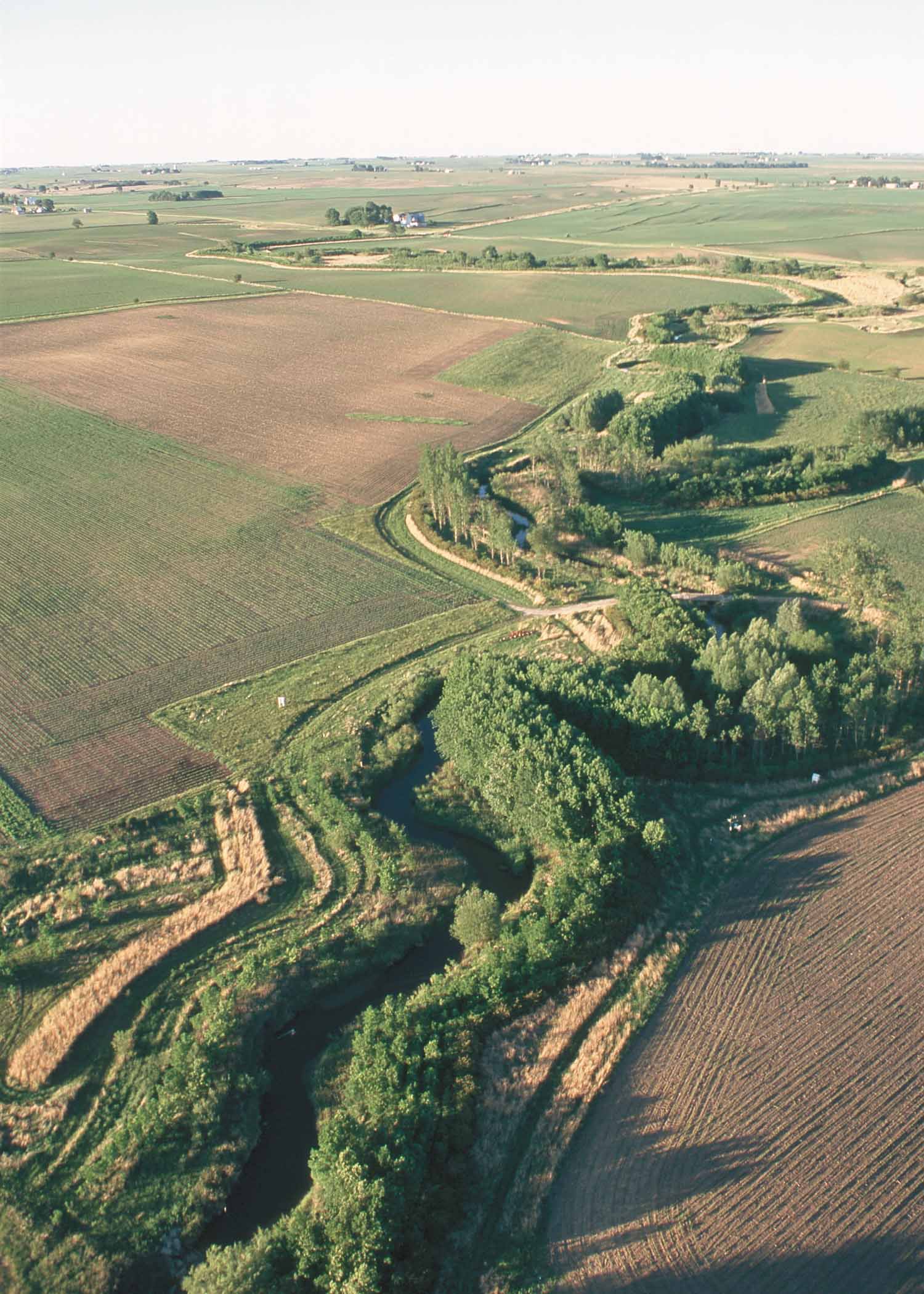Riparian Forest Buffers

Description
A riparian forest buffer is a strip of trees and/or shrubs located adjacent to rivers, lakes, reservoirs, and other inland aquatic systems that affect or are affected by the presence of water (Fischer and Fischenich 2000). This practice involves the protection, maintenance and restoration of riparian forest areas.
Maintaining riparian areas and/or restoring them to a naturally vegetated condition can partially or completely prevent nonpoint source inputs of sediment, organic material, nutrients and pesticides and help to mitigate pollution levels in the river itself, regardless of the source (Cohen 1997). The scope of projects involving riparian forest buffers range widely, from acquisition and protection of wetlands and riparian areas, to a passive "hands-off " approach that allows natural vegetation to become re-established in a mowed or altered riparian area, to a more aggressive approach complete with planting and maintenance efforts.
Calkins Brook, Wilbraham
- Acquisition and Protection: This can involve obtaining easements or full fee acquisition rights for wetlands and riparian areas along streams, bays, and estuaries. It also includes using regulation to restrict activities that have a negative impact on wetlands and riparian areas through implementation of special area zoning and transferable development rights.
- Restoration: Restoration is the return of an area to conditions similar to those present prior to disturbance, by reestablishing the characteristics of riparian areas that promote existing functions, including: vegetative composition and cover, flow characteristics of surface water and groundwater, hydrology and geochemical characteristics of substrate, and species composition (USEPA 2002).
Applicability
This practice is widely applicable and may be used to provide benefits for a range of land uses. For instance, vegetated riparian zones in urban areas, often called "greenbelts" or "greenways," are protected open spaces (usually along stream valleys and rivers) that are managed for conservation, recreation, and non-motorized transportation (Fischer and Fischenich 2000).
Effectiveness
Wetlands and riparian areas provide a source of food, nesting material, habitat, and nursery areas for a variety of terrestrial and aquatic wildlife. Other important functions of wetlands and riparian areas include floodwater storage, erosion control, groundwater recharge, and maintenance of biological diversity. The ability of a riparian forest buffer to remove pollutants is dependent on the width of the buffer, the type of vegetation, the manner in which runoff traverses the vegetated areas, the slope and the soil composition within the riparian area (Cohen 1997). Effectiveness increases with increased detention time, and is reduced significantly in the absence of sheet flow. If the buffer is intended to function as a stormwater BMP, it should be used in conjunction with other BMPs, such as grass filter strips on the outer edge of the buffer to help diffuse runoff. This practice may achieve up to 75% sediment removal, 40% total nitrogen removal, 50% total phosphorus removal and 60 to 70% removal of trace metals (Schueler 1995).
Costs
The cost of protecting and maintaining a riparian buffer zone will vary depending on the scale of the project. The costs of protecting riparian areas are associated with planning, mapping, geographic information systems (GIS), protection programs and pretreatment. An active approach involving planting can cost anywhere from $218$729 per acre, depending on whether machinery is used for planting, the survival rate of the trees, and varying labor costs (Lynch and Tjadin 2000). According to one study that looked at the costs and benefits of buffers, riparian forest buffers can remove 21 pounds of nitrogen per acre each year for $0.30 per pound and about 4 pounds of phosphorus per acre each year for $1.65 per pound (USEPA 2002). National Management Measures to Protect and Restore Wetlands and Riparian Areas (USEPA 2002) has extensive cost and benefit data, as well as case studies and references.
Maintenance
Potential maintenance activities include watering for the first year of replanting or in drought conditions, selective cutting, replanting and weed control (hand weeding or careful spraying). Existing riparian areas need little or no maintenance. Fertilization should be avoided. It is important that maintenance activities do not cause soil compaction, excessive disturbance or impact close to the river (CH2MHILL 1998). Fallen or decaying streamside vegetation in established riparian areas should not be removed. Excessive raking, brush clearing or plant removal can reduce water detention time and breakdown of pollutants by plants and microorganisms (Cohen 1997).
Design Considerations
- The width of the buffer strip is partly dependent on its intended use. For the most part, buffer strips that serve primarily ecological functions, such as wildlife corridor establishment, tend to have wider recommended widths (Fischer and Fischenich 2000).
- Restoring natural riparian vegetation will increase the buffer’s pollution prevention capabilities. Natural, undisturbed vegetation should be maintained to the maximum extent possible. In Massachusetts, this usually means natural forest cover.
- Riparian forest buffers that are used for stormwater treatment are generally designed in accordance with the 3-zone buffer standard, with the width of each zone varying depending on site requirements, such as stream size and topography. See "Pennsylvania Handbook of BMPs" (CH2MHILL 1998) for more information.
- In Massachusetts, riparian areas are specifically protected through the Massachusetts Wetlands Protection Act and the Massachusetts Rivers Protection Act.
References
CH2MHILL. 1998. Pennsylvania Handbook of Best Management Practices for Developing Areas.
http://www.pacd.org/products/bmp/bmp_toc.htm
Cohen, R. 1997. Fact Sheet # 8: Functions of Riparian Areas for Pollution Prevention. Massachusetts Department of Fisheries, Wildlife and Environmental Law Enforcement, Massachusetts Riverways Program. Accessed 8/2/02.
http://www.mass.gov/dfwele/
Fischer, R. A. and J. C. Fischenich. 2000. Design recommendations for riparian corridors and vegetated buffer strips. EMRRP Technical Notes Collection (ERDC TN-EMRRP-SR-31). U.S. Army Engineer Research and Development Center, Vicksburg, MS.
http://www.wes.army.mil/
Lynch, L. and B. Tjadin. 2000. When a Landowner Adopts a Riparian Buffer Benefits and Costs. University of Maryland, Maryland Cooperative Extension, College Park, MD.
http://www.riparianbuffers.umd.edu/fact/FS774.html
Schueler, T. 1995. Environmental Land Planning Series: Site Planning for Urban Stream Protection. Center for Watershed Protection,
http://www.cwp.org/SPSP/TOC.htm
USDA-NRCS. Conservation Practice Job Sheet 391-Riparian Forest Buffer. Conservation Practice Guide Sheets (series). Natural Resources Conservation Service,
http://www.al.nrcs.usda.gov/